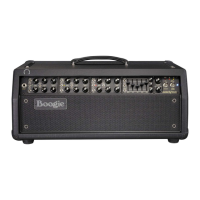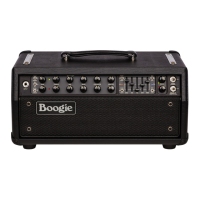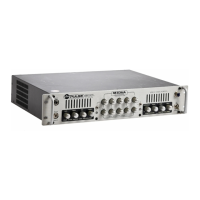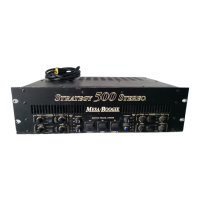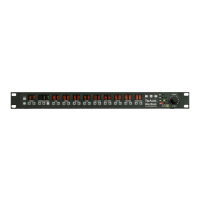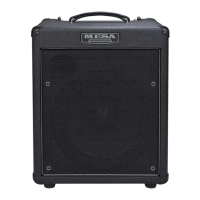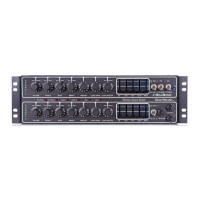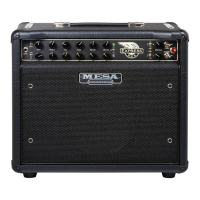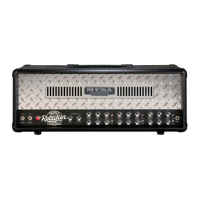PAGE 16
Beyond 2:00, and on through the rest of the GAIN’s rotation, the saturation becomes increasingly thicker and
creamier. This upper region is really where the MARK VII Mode introduces a new Boogie gain voice that falls
sonically between where the MARK IV Mode sits and where “Modified Brit” circuits, like our Triple Crown and
Badlander, hang their hat. It’s got a more aggressive top end and a percussive midrange attack with a chesty
kick in the upper low end that is dierent than MARK circuits with their pronounced higher midrange bump and
more sub-low bottom end that must be used sparingly in the preamp. This hybrid-Boogie may be the perfect
blend between “American” and “Classic Brit” where gain is concerned, as it’s got some of the character of each,
yet has a new personality all its own.
Another great aspect of the MARK VII Mode that helps footswitchability is the fact that it sounds great for Heavy
sounds without the need for the Graphic EQ engaged. This means you can dedicate the Graphic EQ to the
Channel 3 Modes where scooping the mids and boosting lows and highs with the iconic “V” shape or some
derivative on the Slider Pots is more appropriate and creates classic, wide Boogie Heavy Sounds.
With something for nearly everyone, don’t be surprised if the MARK VII’s tonal crossroads become a place you
visit often to bridge stylistic gaps or nail specifics when it comes to your gain needs. That this useful sound rides
alongside the multifaceted sounds in Channel 3’s classic MARK circuits, footswitchably-speaking, makes it all
the more useful for many alternate gain sounds from classic Crunch Rhythm to jabbing or soaring Lead work.
CHANNEL 3
Channel 3 is pure “Boogie” in every sense. Three iconic and versatile Modes reside in this last collection of
circuits, and since Boogie, as the inventor of high gain is synonymous with the term, the MARK VII’s oerings
cover the waterfront and then some.
MARK IIB
First up is a long-requested addition to the MARK Line, the MARK IIB. Famous for its touch-sensitive nuanced
gain and its round attack characteristic, it appears in this rendering as the least saturated of the three “Lead”
Modes in Channel 3. Its perfect blend of smooth, well-attached overdrive excels for “Turbo-Traditional” sounds,
be they blues, roots, classic rock, or nu-country. Over time you will likely find the IIB Mode is the go-to for smooth
saturation that preserves the character of your instrument without covering it up.
A large part of this characteristic of the IIB Mode here in the VII is that the Treble frequencies are centered
higher and in a more traditional range compared to that found in the next two Modes of Channel 3. In the IIC
and MARK IV Modes that follow you have the “Treble SHIFT” - as it relates to the Pull Pot SHIFT feature brought
forward from the IIC and MARK IV models - activated. The result of this auto-activation is enhanced mid focus
and a resulting bump in gain in those frequencies.
That can be a good thing when saturation and high gain styles and are the order of the day, say for vocal-
inspired single note soloing and rock or metal heavy rhythm work. However, if your world orbits styles born of
lower to medium gain levels, the traditional, more “normal” frequencies found here in the IIB Mode are usually
preferred. They allow the overdrive – which is more open and touch sensitive as a result - to surround your
instrument, but not “cover it up” and saturate it to where gain is the most prominent feature.
MARK IIC
Holding the middle spot on the Mode Select toggle, we anchor Channel 3 with perhaps the most famous of all
MARK Modes, the MARK IIC+. This most soaring and searing of all MARK models earned its legendary status
in the Studios of LA in the mid to late ‘80s and subsequently found its way onto the biggest rock and pop tours
of the day. MARK IICs are still highly coveted and bring many times their original price when one can be found
on the pre-owned market.
This iteration here in the MARK VII rivals the originals in our collection and those we’ve borrowed from friends, and
in many ways, we prefer it for its purity of voice and round, balanced Tone. That, coupled with the fact that it sits
alongside all the other toneful circuits and welcomed modern features here in the VII, makes it a clear upgrade.
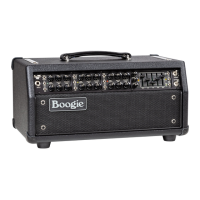
